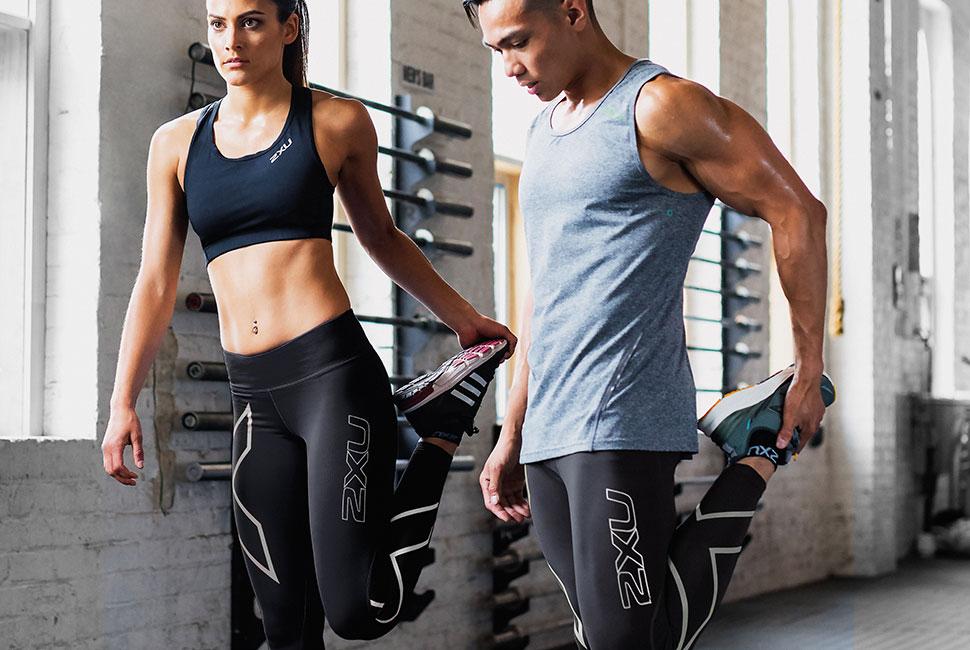Compression wear – from the average gym goer and weekend runner, to the professional athlete. No doubt you’ve seen compression garments being worn plenty of times before. But how effective is compression wear for the non athlete? Is it just a fashion fad or is it a legitimate option for increased performance and recovery? We sat down with Australian Olympic team physio and runner Myles Burfield to discuss.
Are compression garments necessary for increased performance and recovery?
At the amateur level compression garments are not necessary, although they could be beneficial depending on your reasons for using them. From a recovery perspective their use is well supported in the research, and they’re used widely within the elite community for travel and improved speed of recovery post high intensity sessions. Their performance benefits are a little more controversial. Some very weak research suggests that their may be some performance benefits across a few different sports (cyclists, netballers, track athletes) although the size of the studies were small, and the improvements were not ‘statistically significant’. This means that they found small changes but after analysis it was not clear if these changes are due to true benefits from compression garments, or just natural differences between the groups (aka sampling error).
Are they relevant for the casual/semi casual runner, or only for professionals?
In all honesty, if you’re looking for performance benefits as a casual runner you’re unlikely to find them in your compression garments. Although one of the biggest issues for amateur athletes is they often don’t have the time or resources to do optimal recovery (massage, stretching, proper cool downs). Compression garments can really assist when used after long or hard training sessions, or especially when you are training on consecutive days. A good example for many runners would be racing on a Saturday, and then doing a long run Sunday.
In terms of recovery, when is the most optimal time to wear compression garments and for how long?
For recovery compression has been shown to work best when worn within 1 hour of exercising, and kept on overnight. If they are used during exercise benefits have been shown as early as 15minutes post exercise (decreased blood lactate levels in athletes wearing compression), although if you have been exercising without the garments then the priority is to cool your internal body temperature first (water immersion, rest, drinking cool water) before applying compression garments which could make it more difficult to get your body temperature down.
From your experience through the AIS, which brand of compression wear did you find the most effective?
The battle of the brands is mainly between 2XU and Skins, and unsurprisingly they have funded much of the research. The bottom line is that more compression gives you more benefits in circulation, although it is often less comfortable to wear for long periods. There are different levels of compression. These are measured in millimetres of mercury (mmHg). The higher the mmHg, the higher the compression:
8-15 mmHg = mild compression.
15-20 mmHg = moderate compression
20-30 mmHg = firm compression
30-40 mmHg = Extra firm compression
When choosing compression garments for sporting or everyday use I usually recommend moderate compression, and choosing the brand that is the most comfortable. If the garment is a good fit, and compression is applied evenly, it should feel comfortable and non-restrictive. We want increased circulation, rather than circulation blocks.
PHYSIO TREATMENTS
Rehabilitation Planning
If you have been injured, or suffered a serious illness, you may need more than hands on treatment to get you back to full health.
What is rehabilitation?
Rehabilitation is a step-by-step process designed to help you recover from your specific injury or illness. Everyone is different, and it often takes a team of professionals working together to help manage every part of a rehabilitation plan.
Who do we work with?
At Activate Health & Fitness we have a multidisciplinary team including:
- Personal Trainers
- Physiotherapy
- Strength and conditioning experts
- Dietitian
- Massage therapists
We also communicate regularly with general practitioners, specialists, coaches, and other health professionals to make sure your health team is all working towards the same goal (getting you better). Below are some of the local doctors’ clinics and sports medicine centres we have regular contact with:
- https://www.brisbanecitydoctors.com.au/
- http://www.drstaceycompton.com.au/
- http://qsportsmedicine.com.au/index.html
Can I get financial help with my rehabilitation?
For some conditions that are considered chronic conditions and/or complex care needs, your GP can refer you for up to 5 Physiotherapy sessions which will receive a Medicare rebate.This was previously called an Extended Care Plan (EPC), although it has changed to Chronic Disease Management (CDM).
Follow this link or discuss it with your physiotherapist if you think you may be eligible: http://www.health.gov.au/internet/main/publishing.nsf/Content/health-medicare-allied-health-brochure.htm
If you have had an injury resulting in the workplace or on the roads, you may be eligible for assistance. Injuries at work, or motor vehicle accidents (MVA) when travelling to/from work are covered by workcover https://www.worksafe.qld.gov.au/rehab-and-claims/injuries-at-work
Running Analysis
Are you suffering recurrent running injuries? Are you having difficulty completing your training plans? Do you want to improve your running performance? You may need a running assessment!
Recent research shows that 30-50% of recreational will suffer an injury over the course of a 12-month training period. That’s a scary statistic, and the most common causes are:
- Poor technique
- Lack of mobility
- Lack of strength
At Activate we know that the best way to fix running problems is by watching you run…obviously?! A running analysis includes:
- A musculoskeletal assessment for the mobility and strength foundations needed for optimal running technique
- Video analysis of running biomechanics
- A personalised management plan which may include stretches, strength exercises, and running drills to get you running injury free
Book online now!


